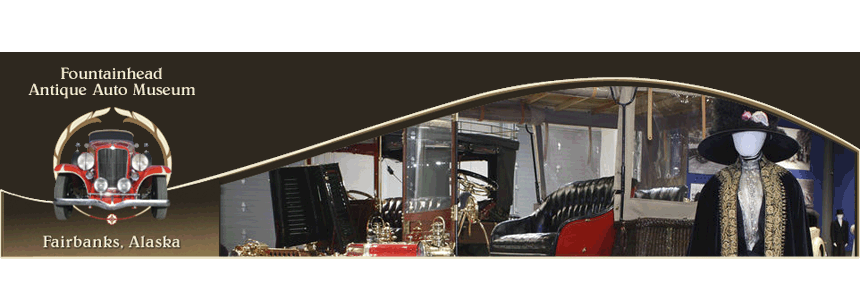© Fountainhead Antique Auto Museum

 Say the word "lingerie dress" and it typically conjures up sexy images from the boudoir, not the streets of Fairbanks in 1910. At the tail end of the Victorian Era a new style of summer dress appeared--a pure white, lace-trimmed gown known as the lingerie dress. As their name implied, these romantic dresses resembled the "unmentionables" that had been worn as undergarments by Victorian ladies. Although a white dress once symbolized wealth, a farmer’s wife was as likely to wear a lingerie dress as was a high-society lady. This style of dress would remain popular through the Edwardian Era until around 1915.
Say the word "lingerie dress" and it typically conjures up sexy images from the boudoir, not the streets of Fairbanks in 1910. At the tail end of the Victorian Era a new style of summer dress appeared--a pure white, lace-trimmed gown known as the lingerie dress. As their name implied, these romantic dresses resembled the "unmentionables" that had been worn as undergarments by Victorian ladies. Although a white dress once symbolized wealth, a farmer’s wife was as likely to wear a lingerie dress as was a high-society lady. This style of dress would remain popular through the Edwardian Era until around 1915.Lingerie dresses were often elaborately trimmed, with lace inserts, appliqués, eyelets, hand-embroidery and ruffles. Yet, they were easy to make, thanks to readily available patterns, machine-constructed laces and sewing machines. Women could sew a dress, stitch the lace in place, and then simply cut away the fabric beneath it. Lingerie dresses could also be bought through mail-order catalogs, and they were among the first mass-produced dresses. At the turn of the century, more than half of the dresses offered in the Sears Roebuck’s catalog were made of white, lace-trimmed cloth ranging in price from $4.75 to $11.
Surprisingly, lingerie dresses were popular with Alaska’s Gold-Rush women, even in the mining camps. Unlike the unwashable silk, velvet, satin and wool dresses of the time, lingerie dresses were usually fashioned from cotton, making them easy to wash at home. Alaska women probably used laundry bluing to keep their dresses white. At right is a photo of Fairbanks ladies at a garden party, probably taken around 1912 (photo courtesy of Candy Waugaman). Several are wearing lingerie dresses, which must have felt comfortable during the warm summer days here.
You can see several lingerie dresses on display in our museum's historic fashion collection. As it has become popular for some brides to wear antique wedding gowns, it is easy to see why Edwardian lingerie dresses are a popular choice for many of them. To view a video of our Lingerie Dress display, please visit our - Fountainhead Museum YouTube Channel.
Reference - vintageconenction.net



There is something about them... They look very lovely yet practical (well, compared to the other dresses of that age) at the same time.
ReplyDeleteGorgeous dresses! Those styles were refreshing simple after the rather ostentatious Belle Epoque years. If I'm ever in Fairbanks I'll have to come see your collection!
ReplyDeleteHi, what kind of underwear were wear under such dresses?
ReplyDeleteSee the answer from our historic fashion consultant below.
DeleteHello! Thank you for your interest in the blog.
ReplyDeleteBeneath the lingerie dresses, women would wear the basic undergarments of the day, which typically consisted of three layers:
The first, worn beneath the corset, included stockings, an undervest (usually a sleeveless, waist length chemise) and drawers, which looked like divided knee length skirts, but could have had the fullness gathered at their hem in the style of bloomers. This layer helped to protect a woman's expensive corset from the soiling of everyday wear.
The most popular corset during the reign of the lingerie dresses was the straight busk corset, which began below the breasts, extended just over the hips, and had a rigid, straight front that thrust the hips back creating the iconic S-curve silhouette of the period.
Over the corset was worn a corset cover (again, typically a sleeveless chemise that extended to the waist) and a petticoat. Combinations, which were garments that incorporated the chemise and petticoat or drawers into one, were also becoming very popular.
Because the lingerie dresses were so fine and often sheer, women could add a punch of color with their chemise, and, depending on the look she wished to achieve, the undergarments' fullness could be controlled through the amount of darting, ruffling, flouncing, and trimming utilized.
Hope this helps!
Abigail Cucolo
Historic Fashion Consultant
Fountainhead Antique Auto Museum